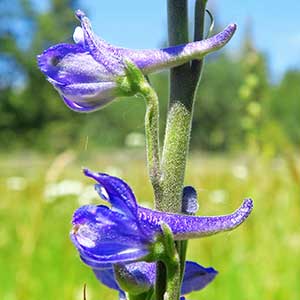Delphinium patens
Delphinium distichum
spreading larkspur, spreading or zigzag larkspur, zigzag larkspur
Burke's larkspur, meadow larkspur, strict larkspur, two-spike larkspur
(10-)20-50(-90) cm;
base reddish, glabrous to puberulent.
(25-)30-60(-80) cm;
base sometimes reddish, puberulent.
blade round to pentagonal, 1-5.5 × 2-7.5 cm, nearly glabrous; ultimate lobes 3-9, less often wedge-shaped, 5 or more extending more than 3/5 distance to petiole, width 5-30(-50) mm (basal), 1-15 mm (cauline), widest at middle or in proximal 1/2.
blade cuneate to semicircular, 1-5 × 1.5-7 cm, puberulent; ultimate lobes 5-19, width 2-8(-15) mm (basal), 0.5-3(-5) mm (cauline);
margins of basal leaf, measured less than 1 cm from blade base, demarcating considerably more than 90° of arc when leaf laid flat;
most cauline leaf blades exceeding internodes.
4-25(-36)-flowered;
pedicel spreading from rachis at usually less than 70°, 1-4(-8) cm, glabrous to glandular;
bracteoles 3-12(-23) mm from flowers, blue to green, linear, 3-8(-16) mm, glabrous to glandular.
8-30(-40)-flowered, usually dense;
pedicel 0.5-1.5 cm, puberulent;
bracteoles 0-3 mm from flowers, green to blue, linear, 4-8 mm, puberulent.
sepals dark blue, usually retaining color upon drying, glabrous, lateral sepals reflexed, (6-)10-15(-20) × 4-8 mm, spurs straight, ascending ca. 30° above horizontal, 8-18 mm;
lower petal blades elevated, exposing stamens, 3-6(-8) mm, clefts 1-3 mm;
hairs centered on base of cleft or on inner lobes, scattered, white, rarely yellow.
sepals dark blue to bluish purple, puberulent, lateral sepals ± erect, 8-12 × 3.5-5 mm, spurs straight, horizontal or nearly so, 9-15 mm;
lower petal blades ± covering stamens, 4.5-6.5 mm, clefts 2-3 mm;
hairs centered mostly near base of cleft, white.
12-23 mm, 3.3-3.6 times longer than wide, glabrous or puberulent.
7-13 mm, 3.5-4 times longer than wide, ± puberulent.
unwinged;
seed coats ± pitted, cell surfaces roughened.
seed coat cells with surfaces roughened.
= 16.
Delphinium patens
Delphinium distichum
Subspecies 3 (3 in the flora).
(Discussion copyrighted by Flora of North America; reprinted with permission.)
Delphinium distichum hybridizes with D. multiplex and D. nuttallianum (D. ×diversicolor Rydberg). The name D. burkei has often been misapplied to D. distichum.
(Discussion copyrighted by Flora of North America; reprinted with permission.)
1. Lobes of proximal cauline leaves usually more than 15 mm wide; basal and proximal cauline leaves rarely cleft more than 4/5 radius of blade. | subsp. hepaticoideum |
1. Lobes of proximal cauline leaves usually less than 15 mm wide; basal and proximal cauline leaves usually cleft more than 4/5 radius of blade. | → 2 |
2. Pedicels puberulent, usually glandular; most leaf blades with more than 7 ultimate lobes. | subsp. montanum |
2. Pedicels usually glabrous; most leaf blades with fewer than 7 ultimate lobes. | subsp. patens |
- Local floras:
BC,
OR,
WA
- Local Web sites:
Flora NW,
PNW Herbaria
WildflowerSearch
iNaturalist (observations)
USDA Plants Database
- LBJ Wildflower Center
- SEINet
- Plants of the World Online
- Encyclopedia of Life
- Wikipedia
- Google Image Search
